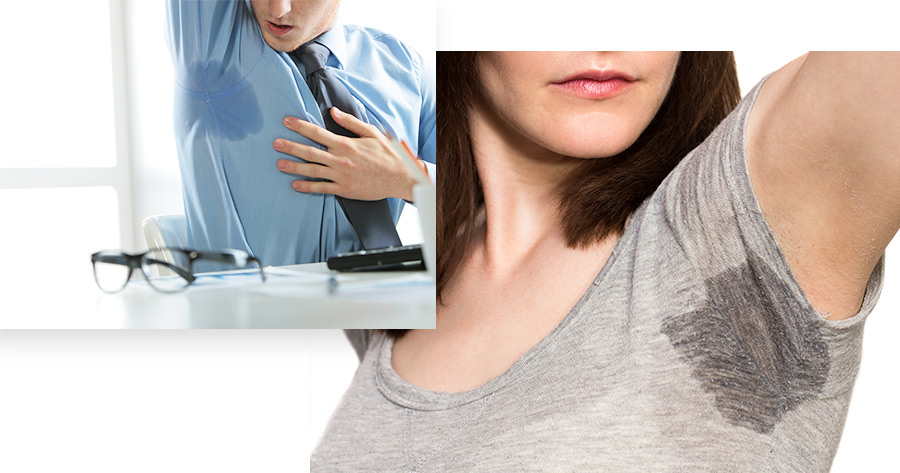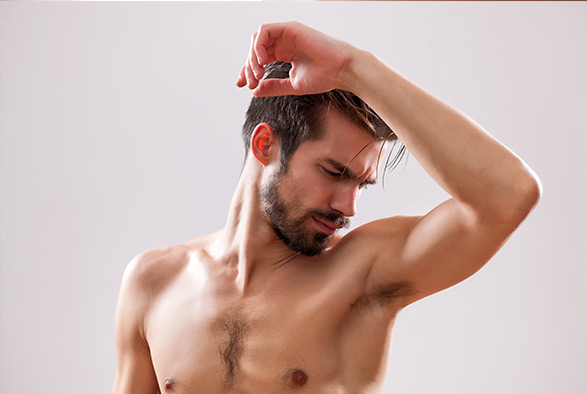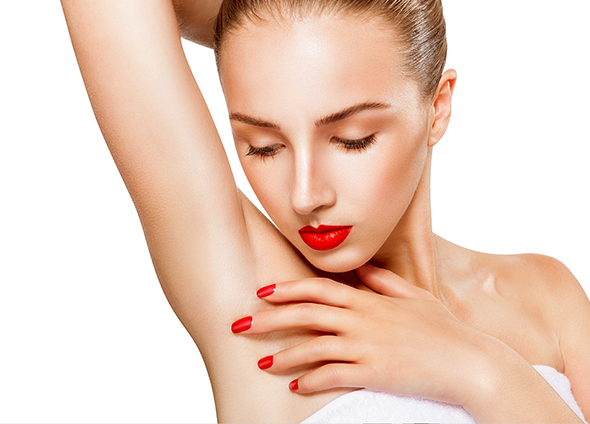
You may be a candidate for miraDry if you are 18 years of age or older and suffer from underarm sweating. Candidates also must be in good overall health. A consultation with your dermatologist will be necessary to determine whether miraDry is right for you.
1. Mark the treatment area
2. Numb the underarm
3. Treat the area with miraDry
4. Enjoy the new sweat-free you!

Hyperhidrosis is a condition that affects a large percentage of the population and has a significant impact on peoples’ lives. This report presents a technical overview of a new noninvasive, microwave-based device for creating thermolysis of sweat glands. The fundamental principles of operation of the device are presented, as well as the design and optimization of the device to target the region where the sweat glands reside.
An applicator was designed that consists of an array of four waveguide antennas, a cooling system, and a vacuum acquisition system. Initially, the performance of the antenna array was optimized via computer simulation such that microwave absorption was maximized near the dermal/hypodermal interface. Subsequently, hardware was implemented and utilized in pre-clinical testing on a porcine model to optimize the thermal performance and analyze the ability of the system to create thermally affected zones of varying size yet centered on the target region.
Computer simulation results demonstrated absorption profiles at a frequency of 5.8 GHz that had low amounts of absorption at the epidermis and maximal absorption at the dermal/hypodermal interface. The targeted zone was shown to be largely independent of skin thickness. Gross pathological and histological response from pre-clinical testing demonstrated the ability to generate thermally affected zones in the desired target region while providing protection to the upper skin layers.
The results demonstrate that microwave technology is well suited for targeting sweat glands while allowing for protection of both the upper skin layers and the structures beneath the subcutaneous fat. Promising initial results from simulation and pre-clinical testing demonstrate the potential of the device as a noninvasive solution for sweat gland thermolysis.
A Randomized, Blinded Clinical Evaluation of a Novel Microwave Device for Treating Axillary Hyperhidrosis: the Dermatologic Reduction in Underarm Perspiration Study Glaser DA, Coleman WP 3rd, Fan LK, Kaminer MS, Kilmer SL, Nossa R, Smith SR, O’Shaughnessy KF. Dermatol Surg. 2012 Feb;38(2):185-91. Department of Dermatology, St. Louis University, St. Louis, Missouri 63104, USA. PMID: 22289389

Duration of effect and effectiveness limit current options for treating axillary hyperhidrosis. A new microwave procedure for treatment of axillary hyperhidrosis has been tested.
Adults with primary axillary hyperhidrosis were enrolled in a randomized, sham-controlled, blinded study. Subjects were required to have a Hyperhidrosis Disease Severity Scale (HDSS) score of 3 or 4 and baseline sweat production greater than 50 mg/5 min. Procedures were administered using a proprietary microwave energy device that isolates and heats target tissue. Responders were defined as subjects reporting a HDSS score of 1 or 2. Subjects were followed for 6 months (sham group) or 12 months (active group).
Thirty days after treatment, the active group had a responder rate of 89% (72/81), and the sham group had a responder rate of 54% (21/39) (P < .001). Treatment efficacy was stable from 3 months (74%) to 12 months (69%), when follow-up ended. Adverse events were generally mild, and all but one resolved over time.
The procedure demonstrated statistically significant, long-term efficacy in sweat reduction. As with any new procedure, findings from this first investigational device study identified optimization strategies for the future.
Clinical Evaluation of a Microwave Device for Treating Axillary Hyperhidrosis Hong HC, Lupin M, O’Shaughnessy KF.
Dermatol Surg. 2012 May;38(5):728-35. Department of Dermatology and Skin Science, University of British Columbia,
Vancouver, British Columbia, Canada. [email protected]. PMID: 22452511

A third-generation microwave-based device has been developed to treat axillary hyperhidrosis by selectively heating the interface between the skin and underlying fat where the sweat glands reside.
Thirty-one (31) adults with primary axillary hyperhidrosis were enrolled. All subjects had one to three procedure sessions over a 6-month period to treat both axillae fully. Efficacy was assessed using the Hyperhidrosis Disease Severity Scale (HDSS), gravimetric weight of sweat, and the Dermatologic Life Quality Index (DLQI), a dermatology-specific quality-of-life scale. Subject safety was assessed at each visit. Subjects were followed for 12 months after all procedure sessions were complete.
At the 12-month follow-up visit, 90.3% had HDSS scores of 1 or 2, 90.3% had at least a 50% reduction in axillary sweat from baseline, and 85.2% had a reduction of at least 5 points on the DLQI. All subjects experienced transient effects in the treatment area such as swelling, discomfort, and numbness. The most common adverse event (12 subjects) was the presence of altered sensation in the skin of the arm that resolved in all subjects.
The device tested provided efficacious and durable treatment for axillary hyperhidrosis.

miraDry is an outpatient procedure performed right in your dermatologist’s office with no incisions necessary. To enhance patient comfort, the underarms are numbed beforehand and the treatment is customized based on your sweat level and armpit anatomy. The miraDry system sends electromagnetic energy through the underarms to eliminate sweat glands.
It is normal for everyone to sweat especially when over-exerting themselves through rigorous exercise, or in the summer months. Sweat is our body’s natural way of cooling itself off. However, some people have a tendency to sweat too much where a thicker and darker colored fluid is produced and it can create rings that stain the clothing. This condition can be embarrassing for people in social situations.
The procedure takes about an hour.
For best results, patients should undergo two miraDry treatments, spaced roughly three months apart. Your dermatologist will provide you with recommendations based on your specific concerns.
After miraDry, you can immediately return to work and other regular activities. It is recommended that you refrain from exercise for the first few days after treatment.
Soreness or swelling may occur after miraDry, but this usually clears in a few weeks. Some patients have temporary, short-term altered sensation in the skin of their underarms or upper arms, which gradually disappears.
No not at all! Anyone who wants to stop underarm sweating can get Miradry. It’s a great non-surgical way to permanently stop your underarm sweating so you no longer need to use antiperspirants.
It’s true that sweating is natural and necessary, and the main purpose of perspiration is to regulate temperature. The armpits however constitute a small percentage of your total sweat glands (only about 2%) and treating your armpits with Miradry will not alter your ability to regulate your body’s temperature.
Yes! Since odor is caused by a combination of sweat with bacteria, when the sweating stops the odor will also stop.
The most common approach requires several injections into each armpit. It can be done with fewer, but you would need to be comfortable with at least a few needle injections.
Miradry has no downtime and patients may resume their normal activities on the same day of treatment. Expected treatment side effects may include swelling and bruising.
Miradry is FDA cleared for patients over 18. That doesn’t mean younger patients can’t be treated though. Patients under 18 years of age have successfully been treated with Miradry. This is a conversation to have with your dermatologist.
Receive skincare tips, news and special offers!